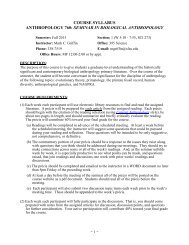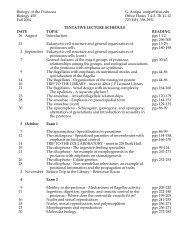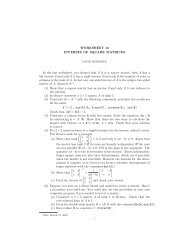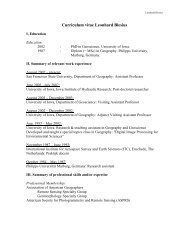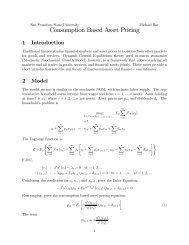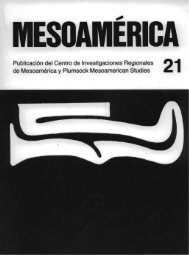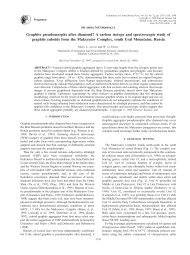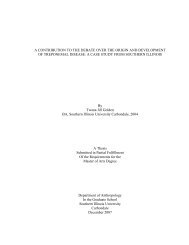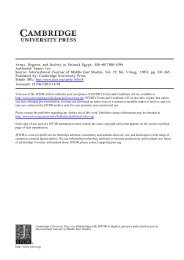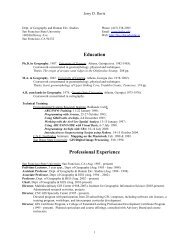Kanno, Kazue Hamada, Masumi Huh, Sorin Jung, Heeyeong - Sfsu
Kanno, Kazue Hamada, Masumi Huh, Sorin Jung, Heeyeong - Sfsu
Kanno, Kazue Hamada, Masumi Huh, Sorin Jung, Heeyeong - Sfsu
Create successful ePaper yourself
Turn your PDF publications into a flip-book with our unique Google optimized e-Paper software.
Processing Strategies used in L2 production<br />
<strong>Kazue</strong> <strong>Kanno</strong>, <strong>Masumi</strong> <strong>Hamada</strong>, <strong>Sorin</strong> <strong>Huh</strong> and <strong>Heeyeong</strong> <strong>Jung</strong><br />
University of Hawaii at Manoa<br />
1. Introduction<br />
Because speech planning and production takes place in a very short time span, there is a need to maximize<br />
processing efficiency. This need is even greater for L2 learners because of their disfluency. This raises the question<br />
of what kind of strategies L2 learners employ in order to facilitate the demands of speech production.<br />
Various factors are thought to play a role in facilitating language comprehension and/or production. Of<br />
particular relevance to our presentation is Ueno & Polinsky’s (2009) suggestion that the number of arguments in a<br />
sentence is a key factor. They propose the following two strategies, both designed to minimize the number of overt<br />
arguments that language users need to produce in the course of speech:<br />
(i) Intransitive bias—intransitive verbs are preferred to transitive verbs:<br />
This strategy reduces the processing load by utilizing more one-place predicates. It is used by head-final<br />
languages such as Japanese as a way to reduce the number of preverbal arguments.<br />
(ii) Pro-drop bias—null arguments are preferred to overt arguments:<br />
This strategy reduces the processing load by reducing the number of overt arguments through the use of prodrop;<br />
it is more common with two-place predicates than with one-place predicates.<br />
The present study investigates how L2 learners of Japanese who are not fully proficient in the language go<br />
about reducing processing load. Specifically, it addresses the question of whether the spontaneous speech of such<br />
learners reflects use of the two strategies proposed by Ueno and Polinsky.<br />
2. Method<br />
2.1 Data used<br />
The data for our study comes from two sets of OPI interview corpora. One consists of interviews with Japanese<br />
native speakers, and the other is composed of interviews with English-speaking learners of Japanese as a second<br />
language. For this particular study, we examined 5 files of native speakers interviews, and 10 files of intermediatelevel<br />
second language learners.<br />
2.2 Targeted structures<br />
Ueno and Polinsky targeted only main clauses, but given the fact that spontaneous speech often involves<br />
incomplete sentences, we decided to target independent clauses—i.e., main clauses, coordinate clauses, and certain<br />
dependent (non-embedded) clauses with absolute tense (e.g., clauses followed by ~(n)kedo, ..kara, and ..shi). A<br />
total of 549 such clauses were extracted from the native speakers’ interviews, and a total of 1,108 from the ten L2<br />
learners’ interviews.<br />
2.3 Coding<br />
The extracted clauses were coded for predicate type (e.g., one-place predicate, two-place predicate, etc.), for<br />
whether they contain subject and/or object pro-drop, for whether they contain a heavy constituent, and for the<br />
location of such constituents. Coding for constituent weight is relevant because this fact is frequently mentioned in<br />
the literature as a determinant of processing difficulty (e.g., Arnold et al., 2000, Yamashita, 2002). For our purposes,<br />
constituents are considered “heavy” when they contain a clause—e.g., a quotative clause, a noun modified by a<br />
relative clause, etc.<br />
3. Results<br />
3.1. Intransitive bias<br />
The use of the intransitive bias strategy predicts that the proportion of one-place predicates should be higher<br />
that of two- or three-place predicates. However, our results show the opposite preference. Just 36% of the clauses<br />
produced by native speakers had one-place predicates, and just 43% of the clauses used by second language learners<br />
were of this type. Our results are thus not consistent with what the intransitive bias predicts.
3.2. Pro-drop bias<br />
The use of this strategy predicts a higher proportion of pro with two- or three-place predicates than with oneplace<br />
predicates. Both our groups exhibit a higher percentage of pro subjects with two- and three-place predicates<br />
than with one-place predicates (82% vs. 48% for native speakers and 75% vs. 29% for the second language<br />
learners). These results are consistent with what the pro-drop bias predicts.<br />
3.3. Constituent weight<br />
Out of 549 clauses produced by the native speakers, 158 (29%) contained at least one heavy constituent. In<br />
contrast, only 94 out of 1,108 clauses (8%) produced by the L2 learners contained a heavy constituent.<br />
More interestingly, the heavy constituents produced by the native speakers tend to occur with pro (about 60%<br />
of the time), whereas no clear tendency was observed in the L2 learners’ production.<br />
4. Discussion<br />
There are three key findings. First, our results show that the intransitive bias is absent in the spontaneous<br />
production of native speakers as well as L2 learners. This calls into question the production-based motivation for<br />
this bias, if in fact such a bias actually exists.<br />
Second, our results show that the pro-drop bias is clearly present, both in native speakers and in L2 learners, as<br />
indicated by the high proportion of this phenomenon with two- and three-place predicates. Based on this, we<br />
conclude that L2 learners as well as native speakers utilize this strategy to facilitate the demands of production.<br />
Our third finding has to do with the factors underlying the use of zero pronouns. It seems that the native<br />
speakers use zero pronouns to compensate for the processing cost associated with the production of heavy<br />
constituents elsewhere in the sentence. In contrast, second language learners use zero pronouns more generally to<br />
simply reduce processing load.<br />
References<br />
Arnold, J. E., Wasow, T., Losongco, A. & Ginstrom, R. (2000). Heaviness vs. newness: The effect of structural complexity and<br />
discourse status on constituent ordering. Language, 76, pp. 28-55.<br />
Ferreira, V. V. & Dell, G. S. (2000). Effect of ambiguity and lexical availability on syntactic and lexical production. Cognitive<br />
Psychology, 40, 296-340.<br />
Ueno, M. & Polinsky, M. (2009). Does headedness affect processing? A new look at the VO-OV contrast. J. Linguistics, 45,<br />
675-710.<br />
Yamashita, H. (2002). Scrambled sentences in Japanese: Linguistics properties and motivations for production. Text, 22, 597-<br />
633.



